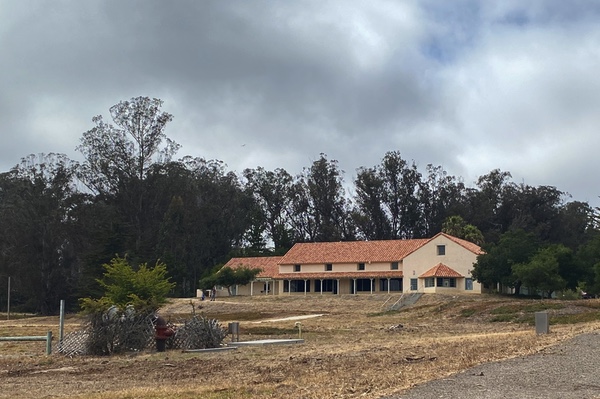Guardians on the West Coast: The Space and Missile Technology Center and Vandenberg museumby Dwayne A. Day
|
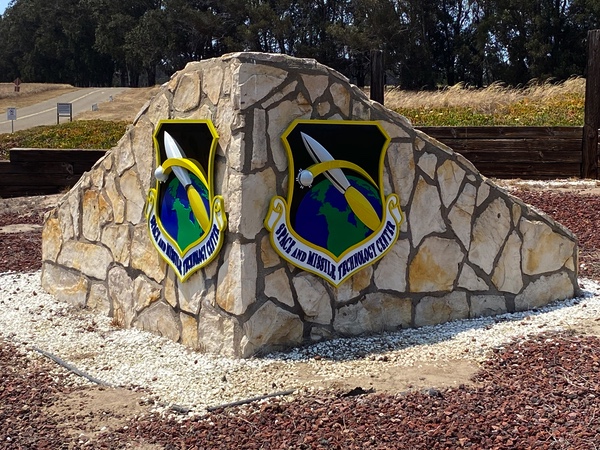 Sign at the entrance to the new Space and Missile Technology Center. Although still on Vandenberg Space Force Base property, it is outside the security gate, enabling the public to visit. (credit: D. Day) |
Vandenberg was formerly Camp Cooke, an Army training base during World War II and Korea that was mostly shuttered by the mid-1950s when the Air Force came looking for a location to shoot rockets and missiles over long distances of open water. The only notable economic activity in the area is a federal prison and agriculture, including flower growing. Throughout the 1960s Vandenberg expanded, acquiring new land and adding new launch sites. But by the 1980s and later it had become rather sleepy, with only a few launches per year. The launch rate is much higher now, bringing new energy and tourism to the area, and hopefully the museum will benefit from that attention.
Vandenberg long had a museum on base known as the Vandenberg Space & Missile Heritage Center, located at the historic Space Launch Complex 10 site only a few hundred meters from the coast. “Slick-10” was where the Air Force launched weather satellites in the 1970s, and where the Royal Air Force practiced launching Thor intermediate range ballistic missiles in the early 1960s. It is only a short distance from the former SLC-1 and SLC-2 pads, the first rocket launch sites at Vandenberg where dozens of CORONA reconnaissance satellites were sent into orbit starting in the late 1950s. Slick-2 later became NASA’s pad for launching Delta II rockets—the last Delta II lifted off there in 2018—and is now used by Firefly Aerospace. The SLC-10 site includes the former blockhouse, rocket preparation building, and support buildings which held artifacts and displays. But SLC-10 is on an active military facility and access was restricted to people who had clearance to be on the base.
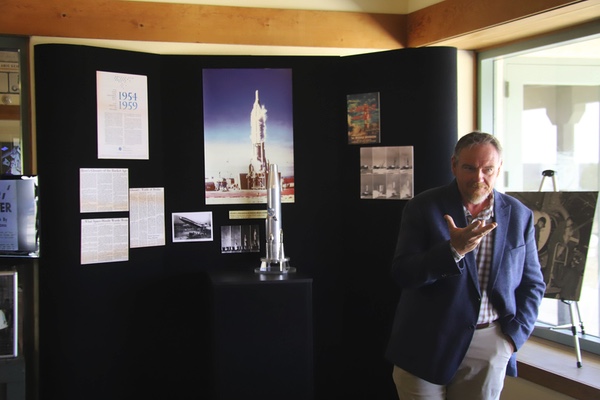 Jay Prichard, the now-former museum director who worked for decades to get the museum moved to a publicly accessible location. (credit: D. Day) |
Getting a publicly accessible museum location has been the goal of museum director Jay Prichard, a former missile technician who has run the museum since the 1990s. Prichard, along with Colonel Mark Shoemaker, commander of Space Launch Delta 30, cut the ribbon to open the new museum on June 24. Prichard sought numerous times to get a retired government building outside of Vandenberg’s security perimeter so that the public could visit and learn the history of Vandenberg. (In the late 1990s, he showed me a former GPS building outside the gate that he wanted for the museum, but that site was not available.)
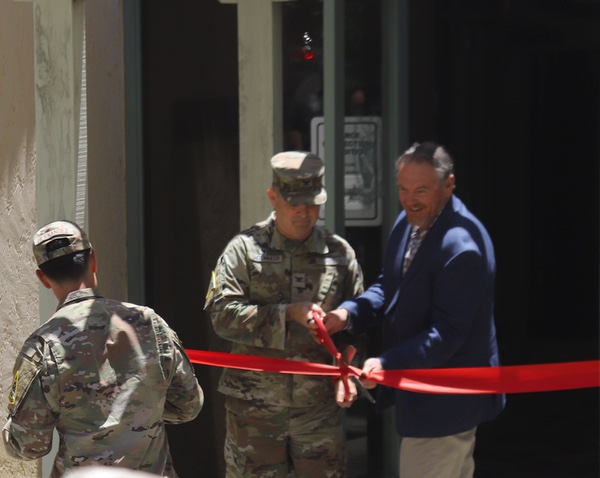 Museum director Jay Prichard, along with Colonel Mark Shoemaker, Commander of Space Launch Delta 30, cut the ribbon to open the new museum on June 24. This was a soft opening, enabling the museum to move to the next phases, including new displays and exhibits, a volunteer program, and non-profit status. (credit: D. Day) |
Finally, in early 2023, Prichard received approval to use the retired golf course, which had been shuttered for nearly a decade. The on-site buildings, including the former clubhouse and a nearby VIP quarters, were in remarkably good condition. Technically, the golf course is on Space Force property and is patrolled by the military police, although visitors do not need to pass through a security gate to visit. Some other parts of the golf course may be redeveloped for other uses. Falcon 9 launches can be seen rising above a ridge line only a few kilometers to the west. Drone flights are strictly forbidden.
Prichard spent over two years clearing brush from the grounds, tearing out old lockers and unneeded furniture, painting and sprucing up, and moving displays from SLC-10 to the new location—in between giving tours at SLC-10. He was occasionally assisted by base personnel and local volunteers. But Prichard is a force of nature and even on weekends could be found out at the location gleefully driving a tractor removing scrub grass.
 A model of a Titan II launch complex and silo. The Titan I and Titan II were both tested at Vandenberg starting in the late 1950s. (credit: D. Day) |
The museum is located in the former golf course clubhouse and divided into two sections, the missiles gallery and the space gallery. Both have long histories at Vandenberg. In the 1950s and later, Vandenberg was the test site for Thor intermediate range, and Atlas, Titan, Minuteman, and MX/Peacekeeper intercontinental ballistic missiles. They were fired out over the Pacific, eventually to Kwajalein Atoll. Even after Atlas was retired as an ICBM it was used to test ballistic reentry vehicles.
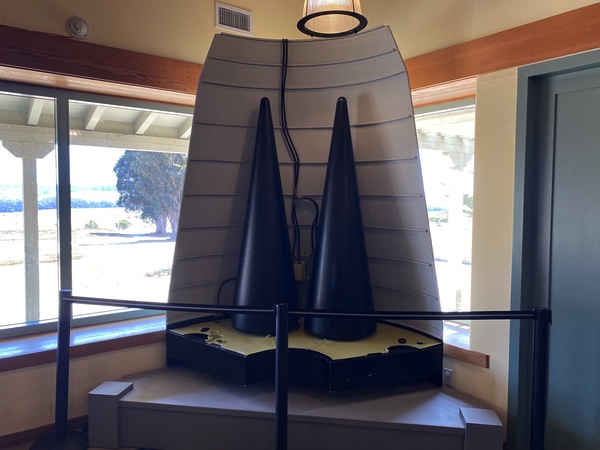 A display of Multiple Independently-targeted Reentry Vehicles (MIRVs) for the retired Peacekeeper missile. Each RV held a nuclear weapon, and the Peacekeeper could carry up to ten MIRVs. (credit: D. Day) |
After development of new missiles ceased, Vandenberg was used for operational tests of ICBMs in the active inventory. Several times a year a Minuteman III ICBM is pulled out of a silo in the Midwest, shipped to Vandenberg, instrumented, and shot downrange. Usually the missiles work as designed, but occasionally something goes wrong.
 The missiles gallery features the many different missiles tested at Vandenberg over more than seven decades, including Thor, Atlas, Titan, MX/Peacekeeper, and Minuteman. (credit: D. Day) |
Vandenberg is also the location of one of two Ground-Based Midcourse Defense sites in the United States (the other is Fort Greely, Alaska). Four interceptors are based at Vandenberg. The program is administered by the US Missile Defense Agency (MDA). Operational control is provided by the Army, and support functions provided by the Space Force and Air Force.
 One of the museum galleries is devoted to space, including the history of the CORONA reconnaissance satellite program that started launching at Vandenberg in 1959 and ran until 1972. (credit: D. Day) |
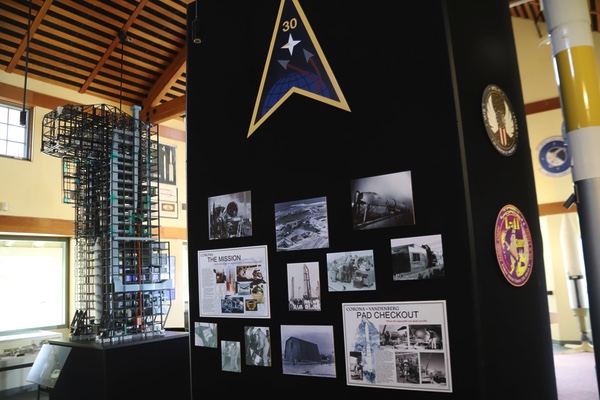 Vandenberg is currently very active as a space launch site. Exhibits include displays and models of the base's space history. (credit: D. Day) |
Starting in the late 1950s, Vandenberg became the site of rocket launches to polar orbit. Thor rockets carried CORONA reconnaissance satellites under the cover of the Discoverer science and engineering program. The program suffered numerous failures before achieving success in the summer of 1960. Other programs, such as Samos and later GAMBIT and HEXAGON, also launched from Vandenberg, taking advantage of its unique geography that allowed launches to the south into polar orbits without overflying land. Whereas Florida was used for launches into relatively low inclination orbits, Vandenberg was the launch site for missions that required orbits of the poles, including photo-reconnaissance, signals intelligence, and meteorology. As the lifetimes of these satellites increased (some have remained in orbit up to 20 years), the launch rate dropped, to the point where it was rare for Vandenberg to launch a reconnaissance or weather satellite.
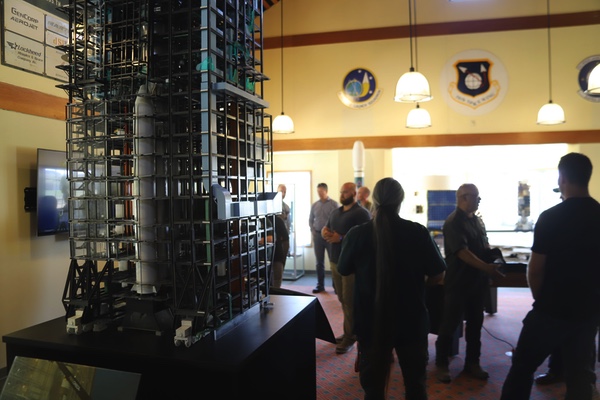 One of the large models on display is the launch tower for Space Launch Complex 4, which was used for Titan IV launches. This tower was unique for having a clean room mounted at its top. It has since been demolished and SLC-4 is now used by SpaceX, which has less infrastructure at the pad. (credit: D. Day) |
The museum exhibits include models of rockets and missiles launched at Vandenberg, a model of an ICBM silo, as well as former launch control consoles and photographs and artifacts of payloads launched from Vandenberg over nearly seven decades of operation. Some of the models are large and impressive, such as a gantry for the former Titan IV launch pad at SLC-4, and a tabletop model of the sprawling SLC-6 complex originally built for the Manned Orbiting Laboratory program, modified for the space shuttle, and then modified again to launch Delta IV rockets.
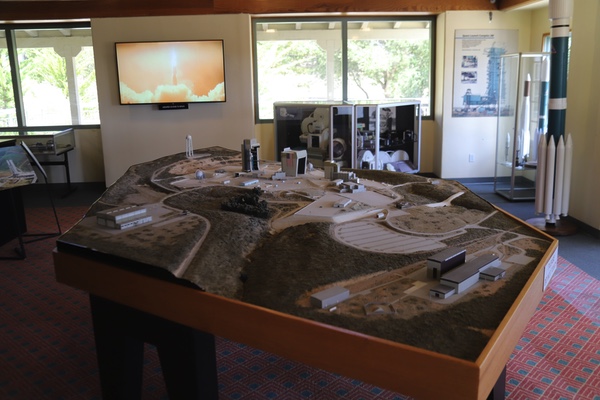 Model of Space Launch Complex 6. Slick-6 was originally developed for launching the Titan IIIM and the Manned Orbiting Laboratory in the late 1960s. It was shut down in 1969 without ever being used, but in the 1980s was converted to launch the space shuttle. When Vandenberg shuttle launches were canceled in 1986, it was mothballed again. In the 2000s it was converted to launch the Delta IV rocket. It is now being turned over to SpaceX and in coming years will be converted to launch Falcon 9 and Falcon Heavy rockets. (credit: D. Day) |
The new space is open to civilians by appointment. It will expand visiting hours in the near future. Right now, the galleries are mostly suited to guided tours, with an expert explaining the importance and history of the artifacts and displays. At the moment, the museum lacks an overall narrative telling the history of the base, the history of the programs developed there, and their importance. That will be added later, and storyboards explaining it have already been created. This was more of a soft opening, getting the museum established outside the gate, enabling new activities like recruiting volunteers and docents to provide tours, and allowing the museum to acquire 501(c)(3) non-profit status so it can accept donations and funding from outside sources.
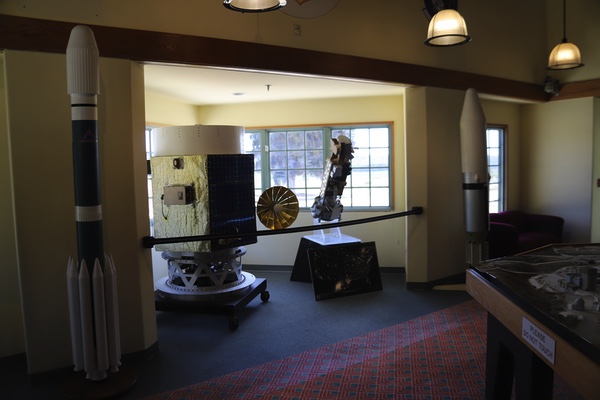 The space gallery features large models of rockets as well as a Defense Meteorological Support Program (DMSP) satellite. At center left is a space vehicle training mockup for teaching pad personnel how to work on and fuel spacecraft. (credit: D. Day) |
There is still much more history to tell. Currently, some programs, like CORONA (1959–1972), are well-represented. Others like GAMBIT (1963–1984), and HEXAGON (1971–1986)—known on the base then as “the big bird”—which included the largest explosion ever at Vandenberg, are not discussed. There are models of the Manned Orbiting Laboratory on display, but no explanation of that program or its significant impact on the history of Vandenberg, which led to a major expansion of the base to the south and a legal battle with a powerful land owner. The museum will eventually include explanation of the history of the local Chumash tribes, who occupied the land for thousands of years before the military showed up. The museum is still a work in progress, and has a big challenge to explain the base, its programs, its people and their history, as well as their context for a public that increasingly has no knowledge of the Cold War that shaped these developments.
 The museum features a display about tracking cameras used at the base. Some cameras are located at the launch sites, but due to fog, the best views are often from tracking cameras on top of nearby mountains. (credit: D. Day) |
Currently several large artifacts remain at SLC-10. These include a Thor Agena rocket like that used for the CORONA program, an Agena upper stage, and a Minuteman training vehicle that was equipped to dispense decoys to fool missile interceptors. These are heavier objects that could not be included in the current location and some will eventually be displayed in a separate building at the ranch. The museum may also acquire a Minuteman missile to stand guard at the entrance.
On the other side of the country, just outside the gate to Patrick Space Force Base in Florida, is the newly renovated Sands Space History Center. That museum tells the history of Air Force missile and space operations at the base. The museum also has a large collection of missile and space artifacts housed on the base, as well as a substantial document and video archive. The Vandenberg museum has been long needed to tell the public the story of the important but often overlooked space and missiles development and operations on the west side of the country. Now, due to Prichard’s hard work and perseverance, Vandenberg can step up to the public stage.
Part 2 will include more photos of the museum.
To schedule a visit or learn more, click here.
Note: we are now moderating comments. There will be a delay in posting comments and no guarantee that all submitted comments will be posted.
